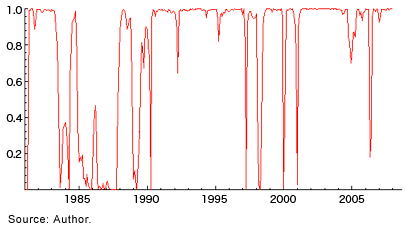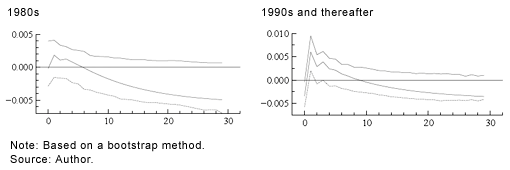The global financial crisis has brought renewed attention to the impact of finance. In a sense, it is not surprising that global financial powers, i.e., countries that had achieved high growth on the strength of their financial sectors, find themselves in a predicament. But countries whose economies did not rely heavily on the financial sector also find themselves suffering just as much in the fallout from the crisis.
The relationship between finance and the real economy
The relationship between finance and the economy is an old research theme that still maintains its relevancy. To be more explicit, it may be rephrased as the relationship between finance and the real economy. If asked which one has a greater effect on the other, most people would point to the real economy as playing the leading role. Indeed, the basic idea that finance would not be anything without the real economy is widely shared. But the causality runs both ways. There have been many cases of finance affecting the course of the real economy. The functioning of the finance mechanism enables central banks, including the Bank of Japan, to operate policy tools, such as moving interest rates up and down, to influence the economy. The current financial crisis is a typical example of the case where causality runs from finance to the real economy.
The qualitative impact that finance has on the real economy is almost axiomatic, but simply making this point would provide little in the way of policy implications. Without understanding the structural underpinnings of an economic mechanism, it becomes very difficult to have an in-depth discussion on effective policies to pursue.
In what follows, I would like to present a simple empirical analysis that emphasizes the importance of such an economic structure. Specifically, by focusing on interest rates and production, and making appropriate adjustments to the method of analysis and indicators used, I can demonstrate how these two closely linked variables affect each other within the overall business cycle. But before presenting the results, I first want to touch upon some technical issues.
Whereas interest rates and production can be objectively expressed in terms of extremely precise numerical values, a business cycle that embraces them is a rather elusive concept. While attempts to objectively size up this ambiguity that we call the business cycle have been made for quite some time, notable progress has been achieved in recent years thanks to the development of sophisticated time-series analysis methods. In this article, I will attempt to provide an overview of the relationship between interest rates and business cycle fluctuations by using a regime-switching model based on James Hamilton's pioneering research to determine business cycle transition probabilities.(* 1)
For the purpose of this analysis, the real short-term interest rate - i.e., the uncollateralized overnight call rate adjusted for inflation - has been used as an indicator of general interest rates, and the index of industrial production (IIP) as the indicator of general production. In the case of the production index, two breakdown indexes - one for investment goods (capital and construction goods) and the other for consumer goods - have been employed to observe structural changes in the economy. Now, take a look at the probability of being in an expansionary phase (Figure 1) based on a two-regime switching vector autoregressive (VAR) model(* 2) using these three variables. As a general indication, the economy is considered to be expanding when the probability is above 0.5 and contracting when below 0.5.

Figure 1: Smoothed Probability of Economic Expansion
The role of interest rates may be changing
In consideration of the lack of rigorous empirical analysis that went into this exercise, we need to allow a margin for error with respect to both the length of period and the degree of changes when we interpret the results of this chart. Still, if we recall the past ups and downs of the economy, we can say with some confidence that the chart captures the general trend fairly well. Nevertheless, there is a possibility that significant changes might have been occurring behind such a seemingly stable relationship, and the mechanism affecting those changes could be described by a single model.
Before making this determination we must first conduct the following next-step analysis. The model estimated above, being a VAR model, can be used to simulate impulse responses to see how the effect of a shock to one variable would spread to the other variables. For instance, an interest rate shock would affect all three variables including the interest rate itself. Furthermore, because the model employed here is a regime-switching model, impulse responses can be examined for both the expansion and contraction regimes.(* 3)
From this analysis we can observe a total of six impulse response patterns (3 variables x 2 regimes). Furthermore, in order to examine the possibility that the variables responding to a shock may do so in correlation to changes in the economic structure, separate computations were performed for the 1980s and for the period in and after the 1990s.
The response of the production index for consumer goods during a contraction phases provides an interesting example. When an interest rate shock occurs, i.e., interest rates rise, the immediate response of the production index for consumer goods is positive. This characteristic holds true regardless of the time frame, and is unique to the production index for consumer goods and does not apply to investment goods. Furthermore, the characteristic was more conspicuous in the 1990s and thereafter than in the 1980s. The comprehensive results show that consumer goods production has responded positively to both rising interest rates and negative shocks to corporate activities, and the degree of this tendency has been increasing.

Figure 2: Impulse Responses of Consumer Goods Production Index to Interest Rate Shocks during Contraction Periods
This may be seen as a reflection of Japan's gradual shift to a domestic-demand led economy - a direct result of an increase in the relative impact of consumer spending. Or it may be interpreted as an indication that consumer spending is receiving temporary stimulation from interest income pushed higher by rising interest rates during the bad economy. Thus, a look at the long-term period spanning the 1980s to the 2000s indicates the possibility that Japan's economic structure has changed substantially more than we may be aware of.
This discussion is based on rough findings from a simple empirical model, so we need to exercise caution when interpreting the results. However, as we gain greater insight into the economic structure, we will be able to draw out various implications. My interest is to deepen the understanding of the relationship structure between finance and the real economy. Since the 1990s, many rigorous research attempts have been made in this field from various perspectives. In this article, I have focused on the role of economic structure in defining the relationship between finance and the real economy. At the same time, however, the possibility of finance affecting the economic structure would be a significant issue.


